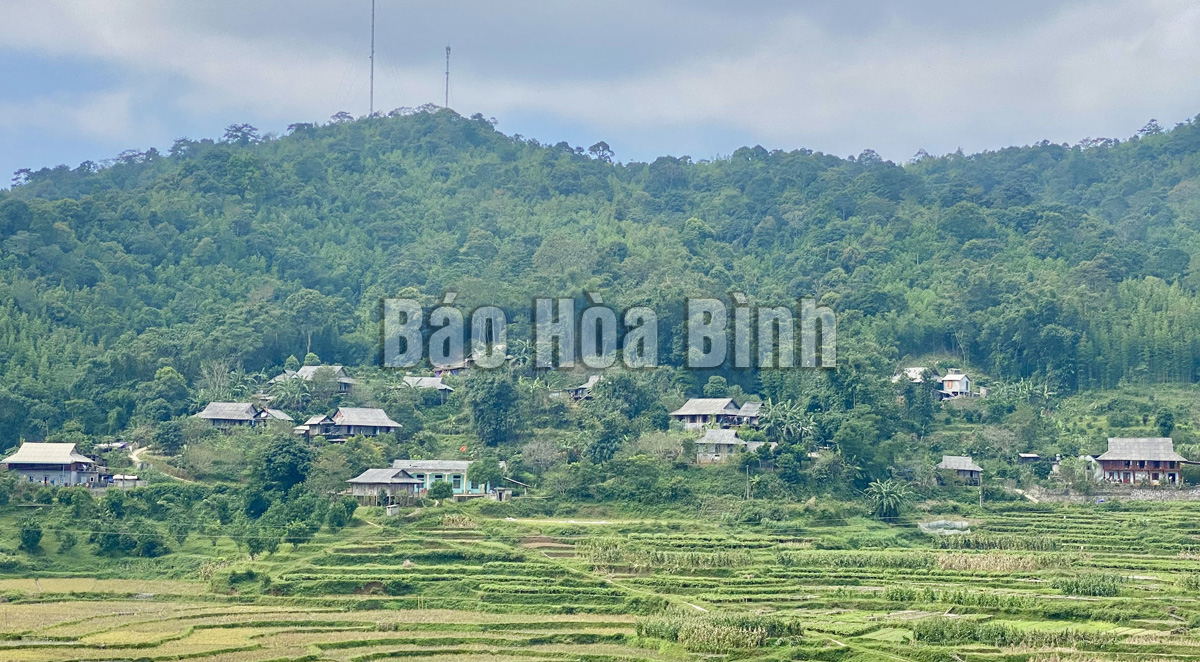
(HBO) - Boasting diverse natural and cultural tourism resources, the three highland communes of Van Son, Quyet Chien, Ngo Luong in Tan Lac district are gradually exploiting their tourism potential and advantages. Recently, the province has issued a resolution and a plan on turning these localities into a provincial tourist area by 2030, with a vision to 2050.

A check-in point in terraced fields
of Lo village in Van Son commune.
Located at 800 - 1,000m above sea level and covered by the forest so the
weather in the above-mentioned communes is always cool in the summer. There are
many beautiful caves in the area, such as Nam Son Cave which is honoured as a
national relic. In addition, there are a number of places to visit and explore,
including Lung Van Peak, Lung Van terraced fields and Quyet Chien
chayotevalley.
The local community also preserves many cultural values associated with the
Muong ethnic identity. They have maintained their stilt houses, household
utensils, and traditional costumes. Many residential areas still preserve
traditional festivals, performances of Mo Muong
-apopularritual ceremony that has become theunique
cultural heritageof the Muong ethnic community in Thanh Hoa and many
otherprovinces in the northern mountainous region,folk songs and
games.
In addition to community-based tourism, the three communes also have the
potential to develop agricultural tourism with some typical agricultural
products namely Nam Son tangerines; off-season vegetables and fruits of Quyet
Chien commune and Shan Tuyet tea.
According to Dinh Son Tung, head of the district’s culture and information
division, despite being affected by the COVID-19 pandemic, its tourism
activities have achieved positive results. In 2019, it welcomed 10,000
tourists, including 3,000 visitors who stayed overnight, earning 2.5 billion
VND in revenue. Incomes from community-based tourism services has contributed
to improving people's living standards.
In order to develop tourism in a sustainable way and attract tourists, the
district will exploit the existing tourism potential while focusing on
preserving and promoting special cultural values as well as building unique and
attractive products. Priority will be given to the development of resorts,
ecological sites and community-based tourism.
It willfocus on mobilising resources and using investment from the State
and from organisations, businesses and individuals to develop tourism,
especially pouring capital into transport infrastructure at destinations and
inter-regional traffic connections.
The development of telecommunications technical infrastructure will be
promoted.
All economic sectors will be encouraged to invest in accommodation facilities,
restaurants, hotels, and recreation facilities.
Attention will be paid to afforestation, forest protection and building
attractive landscapes along roads and tourist attractions./.
A diverse chain of eco-tourism and resort destinations concentrated in Hoa Binh city and the districts of Tan Lac, Da Bac, and Luong Son… Along with the launch of several key high-quality resort tourism projects, these developments have reshaped the landscape and enhanced the appeal of Hoa Binh as a travel destination.
Boasting diverse terrain, a mild climate, and rich natural resources, Cao Phong district is increasingly asserting its place on Vietnam’s tourism map, attracting both domestic and foreign visitors. The district is renowned for its stunning landscapes, majestic mountains, a crystal-clear hydropower lake, and the unique cultural identity of local ethnic groups.
With its pristine landscapes, unique cultural heritage of Muong ethnic minority, and an expanding range of visitor experiences, Tan Lac district of Hoa Binh has fast become a captivating destination for both domestic and international tourists.
Until now, Sung village in Cao Son commune, Da Bac district remains the only Dao ethnic community in Hoa Binh province to develop a community-based tourism model. Beyond its untouched natural landscapes, cultural identity serves as the cornerstone attraction for visitors.
Alongside the diverse cultural identities of the Kinh, Muong, Tay, Thai, Dao, and Mong ethnic people, Hoa Binh province is also renowned as the "capital" of the northwestern Vietnamese cuisine, offering unique and distinctive dishes. At festivals, during Lunar New Year (Tet), or on significant family or community occasions, special dishes are prepared, leaving a lasting impression on visitors.
A Phong Linh (Yellow Tabebuia) flower garden in Thang village, Thach Yen commune, Cao Phong district is currently in full bloom, drawing a large number of visitors.



